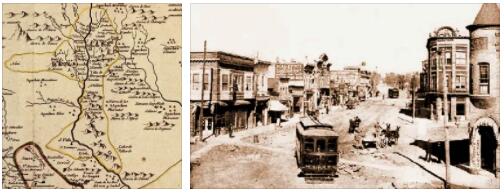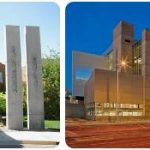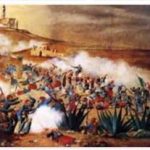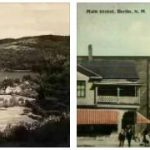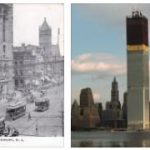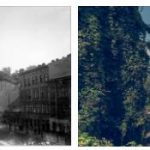Population: 2,082.244 thousand people (2011)
Area: 315194.0 sq. km
The state of New Mexico in the United States is nicknamed the Land of Enchantment. Despite the rather arid climate characteristic of semi-deserts, the natural diversity is great: dense forests in the north, deep river canyons, mountainous regions, and plains.
Due to its significant size (the fifth largest state in the United States), the Sangre de Cristo and San Juan mountain ranges of the Rocky Mountains are located in New Mexico. They cross the state in the middle from north to south. The Colorado Plateau and Llano Estacado are to the west and east, respectively. The northeast is occupied by the Great Plains. The Rio Grande and its left tributary the Pecos are the main rivers of the state. They flow in gorges and form canyons. The climate in New Mexico is continental with little rainfall. Seasonal temperature fluctuations are noticeable. The steppes and semi-deserts of the south give way to the forests of the north and the snowy peaks of the mountainous regions.
New Mexico is the traditional home of the Pueblo, Navajo, Apache, and Comanche peoples. Europeans entered here from Mexico in the 1530s. These were the Spanish conquistadors, prowling in search of “golden cities”. The first settlements arose at the end of the 16th century. In 1605, the New Mexico Territory became a province within the colony of New Spain. The Indian population resisted the aggressive policy of Spain. In particular, in 1680, a large-scale pueblo uprising broke out. Northern areas of New Mexico belonging to France, were sold to the United States (1803), and the rest became part of the Mexican Empire. Only in 1850 was all of New Mexico annexed to the United States, and the modern borders were established in 1863. Since 1912 – the 47th state of the USA. New Mexico is known for the first test of an atomic weapon near Alamogordo (1945).
The unique atmospheric conditions of New Mexico have led to a remarkable astroclimate in the region. More than 10 remote observatories are located in the Myhilla area, which are the object of pilgrimage for astronomy lovers. New Mexico is also known for the settlement of Taos Pueblo, a village on a reservation where the Indians built original buildings and preserve ancient customs and ways of life. The architecture of Albuquerque and Santa Fe is notable for its Spanish influence. The small towns and natural landscapes of New Mexico are in demand by filmmakers.
Alamogordo
Population: 35.607 thousand people (2007)
Area: 50.2 sq. km
Founded: 1912
City status since: 1912
Time zone: UTC-7
Altitude: 1321 m
Zip code: 88310, 88311
City of Alamogordo, the seat of Otero County, is located in the southwestern part of the country. Translated from Spanish, its name sounds like “Thick Poplar”. Near the city is the former Alamogordo test site, on the territory of which the first nuclear explosion in the history of mankind was carried out in 1945. Not far from the surrounding area are two of the country’s largest military bases. The city grew out of a settlement formed in the summer of 1898 during the laying of a railway line. Its subsequent development was associated with the name of Charles Eddy. The owner of the North Western Railway Company had a strong influence on the appearance of the new settlement. Several irrigation canals were built here, interconnected and forming a single network. Wide streets and avenues also became the real embodiment of his plans. Many of them have received the names of celebrities, others were named after universities and states. Highway 54 passing through the city is now beautifully named “White Sands Boulevard”, formerly known as Pennsylvania Avenue.
Many administrative buildings were built in the 1930s, which are now classified as historical buildings. In the Pueblo style, a post office was erected, the entrance of which was decorated with frescoes by Peter Hurd. About 97 kilometers from the city’s outskirts is the former Alamogordo test site. After the first atomic explosion, no more nuclear tests were carried out on it. Now it is considered a historical site, open to visitors in April and October on certain days. At the Holomon military base, located near the city, the chimpanzee Ham, the first humanoid to travel into space, was trained. Its flight time was 16.5 minutes. Not far from the outskirts of the city in the spring of 1982, the Columbia shuttle landed, completing its space flight.
The economy of modern Alamogordo is based mainly on trade, services and tourism. Although industrial production is poorly developed here, it still brings income to the city treasury. In the early stages of its development at the end of the 19th century, the settlement developed as a settlement to serve the railway line. Wooden sleepers were made in local workshops. Over time, the economy changed its direction and the tourism sector began to develop here. She especially strengthened her position after the creation in 1934 of the national monument “White Sands”.
ALBUQUERQUE
Population: 558,000 thousand people (2014)
Time zone: UTC-7, summer UTC-6
Altitude: 1619 m
Albuquerque is an American city in the southwestern part of the state. Albuquerque is the largest city in New Mexico. The Rio Grande flows through the city. Flowing through the city and the desert, it has an “exotic” appearance and resembles the Nile. The Sandia Mountains rise to the east of Albuquerque.
According to the most common version, the city was named after the statesman of Spain, the Viceroy of Mexico, the Count of Albuquerque. The city was founded in 1706 as a Spanish colonial post. Ranchos de Albuquerque is its original name. The main occupation of the inhabitants of the city at that time was farming, and the city itself was a military post along the Camino-Real road. Albuquerque was also a sheep breeding center. From the date of the founding of the city, the Spaniards had their military garrison here, and in 1821 the Mexicans also placed their own here. From 1846 to 1867, Albuquerque was home to a federal garrison of the American army.
By the beginning of the 20th century, the city already had all modern conveniences. Due to the dry climate, many tuberculosis patients came here in search of treatment. Through the creation of the Kirtland Air Force Base and the Sendia Base, Albuquerque has become a key player in the Atomic Age. By the 1970s, many historic buildings were destroyed. An interesting fact is that in 2007 Albuquerque was included in the list of the fastest growing cities in America.
The modern city retains a large share of the Spanish cultural heritage. One of the attractions of Albuquerque is the city biopark. This is a complex that includes: an aquarium, a zoo and a botanical garden. On the eastern outskirts of the city there is a cable car – one of the most popular attractions. Other places of interest in the city include: the Museum of History and Nuclear Science, a small amusement park (Cliff Amusement Park) and the Petroglyph National Monument. The city is also famous for its annual hot air balloon festival. This event is the most important event of its kind in the world.
Roswell, New Mexico
History and Climate of Roswell, New Mexico:
History: Roswell, New Mexico, is a city with a history that has become synonymous with one of the most enduring and famous UFO-related incidents in popular culture. However, beyond the extraterrestrial lore, Roswell has a rich history dating back to the late 19th century.
Founded in 1869 when Van C. Smith purchased land from Joseph Ballard Atherton, Roswell was initially a small agricultural and ranching community. The establishment of Fort Stanton nearby and the arrival of the railroad in the 1890s contributed to the town’s growth. Agriculture, particularly cattle ranching and farming, played a crucial role in the local economy.
Roswell’s transformation into a prominent city in southeastern New Mexico gained momentum in the early 20th century. Oil was discovered in the region in the 1920s, leading to an economic boom. The Walker Air Force Base, established during World War II, further fueled the city’s growth, becoming a vital hub for military activities during the Cold War.
The city gained international attention in 1947 due to the infamous Roswell UFO incident. Reports of a crashed unidentified flying object sparked widespread speculation about extraterrestrial encounters. The incident has since become a focal point for UFO enthusiasts and conspiracy theories, contributing to Roswell’s reputation as a center for UFO-related activities.
Today, Roswell embraces its UFO history, with the International UFO Museum and Research Center serving as a popular attraction. However, the city is more than just a UFO hub; it is a thriving community with a diverse economy that includes agriculture, oil and gas, and aerospace industries.
Climate: According to Barblejewelry, Roswell experiences a semi-arid climate, characterized by warm temperatures, low humidity, and distinct seasons.
- Summer (June-August): Summers in Roswell are hot, with average high temperatures ranging from the mid-90s to over 100 degrees Fahrenheit. The city experiences low humidity levels, making the heat more tolerable. Summer is the driest season, and residents and visitors often seek relief in indoor activities or water-based recreation.
- Fall (September-November): Fall brings a gradual decrease in temperatures, with average highs ranging from the mid-70s to mid-80s Fahrenheit. The weather is generally pleasant, and fall foliage adds a touch of color to the landscape. Outdoor activities become more enjoyable during this season.
- Winter (December-February): Winters in Roswell are mild, with average high temperatures ranging from the mid-50s to mid-60s Fahrenheit. While frost is possible, snowfall is infrequent. Winter nights can be cool, but overall, the climate remains relatively temperate. It’s a comfortable season for outdoor pursuits.
- Spring (March-May): Spring sees a gradual warming of temperatures, with average highs ranging from the mid-60s to mid-70s Fahrenheit. As vegetation comes to life, spring is an inviting time for outdoor activities, and the city’s parks and green spaces become popular destinations.
The climate in Roswell is influenced by its location in the high desert of southeastern New Mexico. The city’s arid conditions and wide-open spaces contribute to its unique atmosphere and offer clear skies that attract both astronomers and UFO enthusiasts.
In summary, Roswell, New Mexico, is a city with a diverse history that extends beyond its UFO lore. The region’s economic evolution, from agriculture and ranching to oil and aerospace industries, has shaped its identity. With a semi-arid climate, Roswell experiences distinct seasons, making it an appealing destination for those interested in both its historical significance and natural surroundings.
